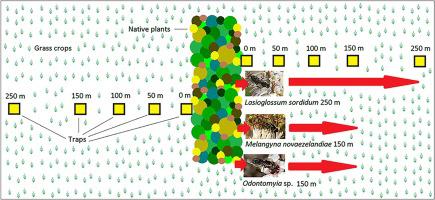Journal of Asia-Pacific Entomology ( IF 1.5 ) Pub Date : 2021-07-14 , DOI: 10.1016/j.aspen.2021.07.005 F.G. Schmidlin 1 , J.J. Sullivan 1 , M.H. Bowie 1 , S.F.J. Read 2 , B.G. Howlett 2

|
On-farm native plantings support insect pollinator diversity, however, they must move between this habitat and crops grown elsewhere on the farm if they are to have any possibility of delivering pollination services that benefit growers. To determine whether pollinator movement occurs, sticky traps to capture verified crop pollinating insects (bees and non-bees species) were placed at distances of 0, 50, 100, 150 and 250 m from 5 year old native plantings into adjacent grass crops on three farms in New Zealand. These were activated twice for 48 h in Dec 2017 and Jan 2018. Captured pollinators were examined for pollen originating from the native plantings. A total of 993 individuals from 13 crop pollinating species were counted of which 506 were examined for pollen. Eight individuals representing three pollinator species were found with pollen sourced from the plantings. Of these, the native bee Lasioglossum sordidum (n = 4) was found to have travelled up to 250 m, while the native flies Melangyna novaezelandiae (n = 3) and Odontomyia sp. (n = 1) travelled up to 150 m. Despite finding few pollinators moving between these habitats, we recommend further studies to assess (1) whether the current study is truly indicative of limited pollinator movement across these habitats at broader temporal (e.g. seasonal and yearly), spatial and system scales (e.g. a broader range of agriculture systems and regions). Such knowledge can inform farmers on whether or not it is worthwhile establishing on-farm native plantings to support pollinators.
中文翻译:

检测到少量蜜蜂和非蜜蜂传粉者在农场本地种植和邻近的草地农田之间移动
农场本地种植支持昆虫传粉媒介的多样性,但是,如果它们有可能提供有利于种植者的授粉服务,它们必须在这个栖息地和农场其他地方种植的作物之间移动。为了确定传粉媒介是否发生移动,在距离 5 年生的本地植物 0、50、100、150 和 250 m 的距离处放置了用于捕获经验证的作物授粉昆虫(蜜蜂和非蜜蜂物种)的粘性陷阱,并在三个新西兰的农场。这些在 2017 年 12 月和 2018 年 1 月被激活两次,持续 48 小时。检查捕获的传粉媒介是否来自本地种植的花粉。共统计了来自 13 个作物授粉物种的 993 只个体,其中 506 只进行了花粉检查。发现了代表三种传粉媒介物种的八个个体,其花粉来自种植园。其中,本土蜜蜂Lasioglossum sordidum (n = 4) 被发现已经飞行了 250 m,而本地苍蝇Melangyna novaezelandiae (n = 3) 和Odontomyia sp。(n = 1) 行进了 150 m。尽管发现很少有传粉媒介在这些栖息地之间移动,但我们建议进一步研究以评估 (1) 当前的研究是否真正表明在更广泛的时间(例如季节性和年度)、空间和系统尺度(例如更广泛的范围的农业系统和区域)。这些知识可以告知农民是否值得建立农场本地种植以支持传粉媒介。



























 京公网安备 11010802027423号
京公网安备 11010802027423号